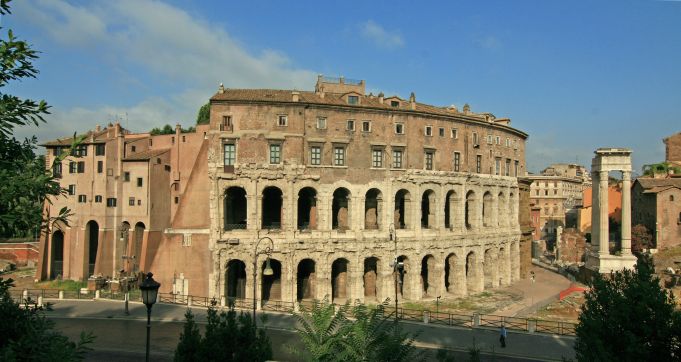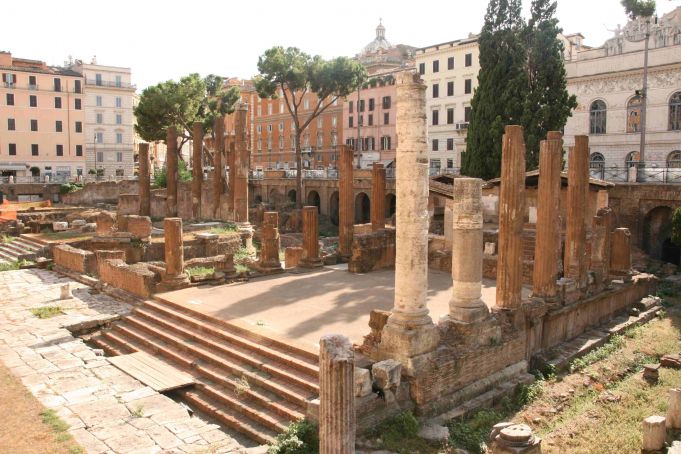Where have Ancient Rome's buildings gone?
Over the millennia, imperial Rome's splendid buildings have been damaged, plundered, redesigned and then recycled into the fabric of the modern city.
Ruins and artefacts re-emerging is, Rome being Rome, an everyday event. Equally fascinating is how they disappeared in the first place. “Speak, o stones,” Goethe, visiting the Forum, begins his Roman Elegies, although sometimes also the holes can have voices. To cite a conversation overheard while on a tour-bus rounding the Colosseum: “It looks like a massive cake.” Then, in a similarly Texan accent, “Yeah, honey, and the ants got at it.”
In many an ancient pile, the first element to vanish is metal; those holes in the Colosseum were once filled with iron clamps, 300 tons worth by one account, securing 100,000 cubic metres of travertine. As depicted on a surviving coin, also missing are statues adorning the arches in the second and third tiers, along with the vast bronze shields or medallions Diocletian placed on the fourth.
Barbarians and Barberini
The “ants” mentioned above were probably the barbarians, with metal, precious or base, being eminently portable once melted down. Edward Gibbon notes in his Decline and Fall of the Roman Empire, first published in 1776, that “every traveller who views the Farnese Palace may curse the sacrilege and luxury of those upstart princes.”
Similar blame is apportioned to the Barberini papacy’s dismantling of the bronze beams of the Pantheon’s portico to build cannon, then to supply material for Bernini’s baldacchino in St Peter’s. “What the Barbarians couldn’t do the Barberini completed,” went a quip posted on the Pasquino (talking) statue nearby.
Yet Byzantine emperor Constans II had been here even earlier. On a 12-day visit in 667, he stripped the bronze from the Pantheon’s dome to adorn his capital Byzantium, topping up his booty with marble ripped from the Basilica of Maxentius in the Roman Forum. Not that he got to enjoy his pickings. Stopping in Sicily, he was murdered in his bath.
Visigoths
A variant of “You can’t take it with you” is Alaric the Visigoth. In 410, gold, bronze, iron and furniture were all literally carted away in a three-day rampage. True, Alaric did allow the old St Peter’s and St Paul’s basilicas to be used as a refuge. That didn’t stop the abduction of Emperor Honorius’ sister, subsequently given to Alaric’s brother in marriage. History relates the bride’s shock on receiving wedding gifts of 100 cups a-brim with valuables she recognised as having been stolen from her fellow Roman matrons.
The Julian and the Aemilia basilicas in the Roman Forum were torched, the latter’s flooring imprinted with molten coins dropped by a fleeing money-changer. Alaric headed south to Sicily, only to fall ill near Cosenza. His armoured body, horse, loot are all buried in a nearby river, first diverted and then redirected back on course to foil treasure-hunters.
Vandals
The Vandals, in 455, were more thorough. The Visigoths used carts; the Vandals, with a kingdom stretching from Tangiers to Tunis, carried off their booty by the shipload, their rampage lasting weeks rather than days. Vessels were moored along the Tiber, two of them for hostages, one for men, one for women and children, each worth their weight in lucre.

The gilded roof-tiles of the temple of Jupiter on the Capitoline hill served to decorate Genseric’s palace in Carthage, as did the Menorah and other Jewish treasures of the Forum’s strangely-named Templum Pacis.
Full-scale neglect
Come the late sixth century, full-scale neglect sets in. Aqueducts become inoperative and baths and theatres are left to crumble as Rome’s ruling classes fled to Byzantium, sometimes taking statues with them; the four bronze horses Venice brought back from Byzantium may once have adorned Hadrian’s tomb. Monuments beyond repair were dismantled and/or burned down for quicklime. Sinking under its rubble (frequent fires were also a factor), the Forum was renamed Campo Vaccino, cattle replacing monuments; Basilica Iulia became part building yard for the marble-crushers, part hemp factory.
Colosseum
The Colosseum continued for a while to be used for entertainment, although areas under the vaults were transformed into workshops and housing and the arena became a cemetery. By the Middle Ages, parts of it were turned into a fortress by the powerful Frangipani family who ruled over Rome. After numerous lightning strikes and earthquakes, it eventually became a quarry.
In 1452 it is recorded that one quarryman alone carted away 2,522 barrow-loads of precious travertine. Teatro Marcello morphs into Monte Savelli, named after another warring Roman family. Eliogobalus’ (private) amphitheatre dwindles to an elegant bulge in the Aurelian wall (near S. Croce in Gerusalemme.)
Pompey's theatre
The disappearance of Pompey’s theatre, once the world’s largest, was accelerated by the annual flooding of the Tiber. It also ended up as a convenient quarry for the mediaeval buildings springing up around Campo de' Fiori and the Rennaissance Palazzo della Cancelleria.
Some ancient structures are now detectable only by the architectural symmetries above them. Two streets behind Largo Argentina replicate the curved platea of Pompey’s theatre. The circular church of S. Bernardo alle Terme likewise reflects the spheristum, or indoor ballpark, of Diocletian's baths, while the lower sweep of Piazza Repubblica partly reincarnates the baths’ exedra, reflected in the square's former name, Piazza dell'Esedra, still often used today.
And the Calidarium? Thanks to Michelangelo’s re-design, it is there in the concave entrance of S. Maria degli Angeli e dei Martiri. The baths' giant cistern, however, disappeared completely during the construction of Rome's central train station, Stazione Termini (1860-76), named after the baths nearby.

Gibbon also cited hostile attacks by early Christians. True, in 383 pagan worship was abolished and a decade later temples were closed. But by occupying monuments, Christians could also protect them. The Forum’s curia survives partly due to its conversion into a church; a Christian wall fresco flanks two friezes depicting Trajan.
Romulus’ temple is the Forum’s best preserved monument, having being enfolded inside SS. Cosima and Damiano. The columns of the nearby Antoninus and Faustina temple form the original façade of S. Lorenzo in Miranda; notice their colour change toward the top, which is an indication of how deep they were once buried. And then, who knows what might have happened to the Pantheon but for its sixth-century consecration?
Depredation of the Colosseum ceased after 18th-century Pope Benedict XIV placed the Stations of the Cross there, and Trajan's column still stands because its top was used for centuries to house St Simon Stylites-type hermits.
Pagan times
In more recent times it was S. Clemente’s Irish Dominican fathers, who in 1912 saved the mithraeum three floors underground from flooding by building a 700-m long tunnel linking it to the Cloaca Massima, the city's main drain. At SS. Giovanni and Paolo on the Celio, the rector initiated excavations in 1887 that were to uncover not three levels but several: the two martyrs’ burial place, then a fourth-century AD domus and below that third- and second-century insulae.
So in an archaeological labyrinth, pagan nymphaeum and baths rub walls and/or ceilings with nooks of palaeo-Christianity. Not to mention the subterranean jewel of what must rank as Rome’s snuggest and most oddly-situated museum to house artefacts; proceed downhill past SS. Giovanni e Paolo, and the Case Romane del Celio is tucked below on the right.
Damnatio memoriae
Another agent of disappearance is “damnatio memoriae”, whereby a new emperor sought to cancel all reference to a perfidious predecessor. Domitian’s horse in the Forum and Caracalla’s cruel erasures of his murdered brother, Gaeta, are examples. (Marcus Aurelius’ statue survived after early Christian emperors mistook it for Constantine’s.)
These days, a similar if less discriminating annihilation is the traffic fumes eating away the statuary of many a triumphal arch or column, flattening the finely-carved facial features. Vanished, one might say, literally into thin air, supplementing the list of other antiquities looted, burned down, displaced or re-incorporated. Or, on a more positive note, awaiting the touch of archaeologist’s laser and trowel to conjure them back into the daylight.
By Martin Bennett
This article was first published in the June 2019 edition of Wanted in Rome magazine.
Cover image: Byzantine emperor Contans II removed the marble from the Basilica of Maxentius in 667.
















